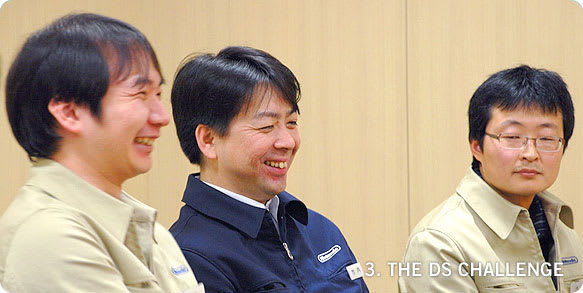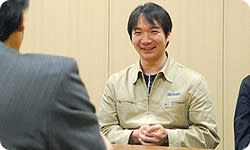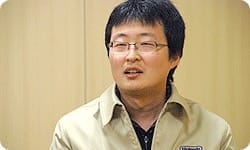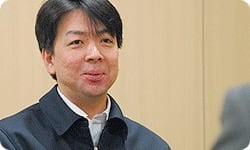The DS Challenge
Then, as development of the arcade game progressed, the challenge of figuring out what the next game in the series would be like began. And it wasn’t easy. Right, Osawa-san?
…that’s right.
As I watched you work on the WarioWare series and Rhythm Tengoku, it appeared to me that your work style is to experiment as you grope around for a clear conception of the game. You create a temporary working model, and, as others use it, they get an idea of what it’s supposed to be like, and then go along with you. However, this time you had to start with basic research by studying the Nintendo DS system.
Yes, that’s right. I studied the hardware, as well as a new programming language and format. Meanwhile, I pondered over how the stylus could be used for gameplay.
I suppose that wasn’t easy to figure out. An important element, the essence, of Rhythm Tengoku for Game Boy Advance was the feeling of pressing buttons to exact timing. I’ve heard that a lot of thought was put into elements such as sound and programming in order to achieve that feeling. Were you in charge of that, Yone-san?
Yes. Every game is the same in that when you press a button, it has to respond, but for the Game Boy Advance version of Rhythm Tengoku, we really put a lot of effort into a means of clearly expressing to players an immediate response so they would think, "I just pressed a button!" Specifically, we paid attention to making sure the sounds for each sound effect would stand out sharply and clearly.
If input precision is important, buttons might be more suitable than a stylus.
That’s right.
But if you’re going to come out with Rhythm Tengoku for DS, you want to use the stylus. So how do you give players that precise feeling of keeping the rhythm with a stylus? I imagine you must have wrestled with that.
…Yes. That more than anything. To be honest, toward the beginning, I thought if it didn’t work out, I would have to think about returning to button input. But at the same time, since the hardware had evolved, I didn’t like the idea of players having to do the same old thing.
It’s a difficult area. It seemed to me that it was taking a long time, that preparatory research was dragging on.
For example, at first we considered an input method whereby you would touch the edge of the touch screen with the stylus and it would make a tapping sound. But…that seemed a little too difficult.
You wanted something that would feel satisfying.
Yes. Then we decided to try out a flicking action with the stylus, which became the source for the flick movement we eventually adopted. But the points where you have to use some strength and flicking the stylus took a little getting used to. So we carried on a lengthy process of trial and error to make it feel right to the player, all the while considering whether we should return to button input. In the end, we realized that if we combined sound with the flicking action, you can get a good sense of the timing, and decided on using the stylus…
How long did that process take?
Let’s see… About two to three months for background research, and after that… More than six months, I’d say.
Yes, I’d say you were struggling at it for about six months.
I agonized over it forever.
Yeah, he was in grueling agony for quite some time.
Osawa the Seeker was in the throes of agony. Takeuchi-san, how did you try to come to his aid?
I couldn’t do anything.
(laughs)
For the time being all I could do was try out what he’d come up with and say, "Hmm, I don’t really get it but…it’s fun!" or "C’mon! You can do it!" (laughs)
But when you praised him without really understanding, I bet he wasn’t pleased at all.
You guessed it! He wouldn’t buy it at all!
(laughs)
…
He’s a perfectionist. When he isn’t pleased himself, it doesn’t matter what others say.
That’s right. Exactly right. We’ve known each other for a long time, but that’s one area where we still don’t understand each other.
(laughs)
…
But every time Osawa-san comes up with something, it’s always something you’ve never seen before. That’s where their appeal lies. There’s nothing to do but go along with him.
That’s true. When you play the final version of Rhythm Heaven, despite the relatively few controls, you’re surprised by the wide variety of effects and the abundance of ideas it presents.
Yes, that’s right.
…
Osawa-san was the central mastermind, with Takeuchi-san and Yone-san following along, in charge of graphics and sound, respectively. That’s the same pattern as with the previous game, but Yone-san, you weren’t on the team yet during the time Osawa-san was agonizing over it, were you?
No, I hadn’t joined yet. I was making the Wii Channels at that time.
Oh, that’s when you were working on the features of the Wii console.
Yes, but I could tell Osawa-san was in pure agony, so I wanted to go to his side as soon as possible.
What a nice team! (laughs) You wanted to help him out as quickly as you could.
…
Then, when I had some time, I whipped together a sound sample and showed it to him, but he was like, "Hmmmmmmm…" (laughs) So I said I’d try again and come back later.
That you’d be back.
Right. It’s not the kind of thing you can throw together in your free time.
That’s right. When it comes to Osawa-san, you’ve got to give it your body and soul.
That’s because he himself gives it his body and soul.
…
He absolutely does.
When I watch Osawa-san making games, I get a sense of the mystery, the depth, the brilliance of making video games. Most people who play video games probably do not know about how video games are made, but putting together one single game is a lengthy process of trial and error integrating game operation and the structure of gameplay with a theme, a single concept, running through it all. How should I put it? In order to create one thing, you explore its potential, and tie it all together into one bundle. Not very many things are made that way.



